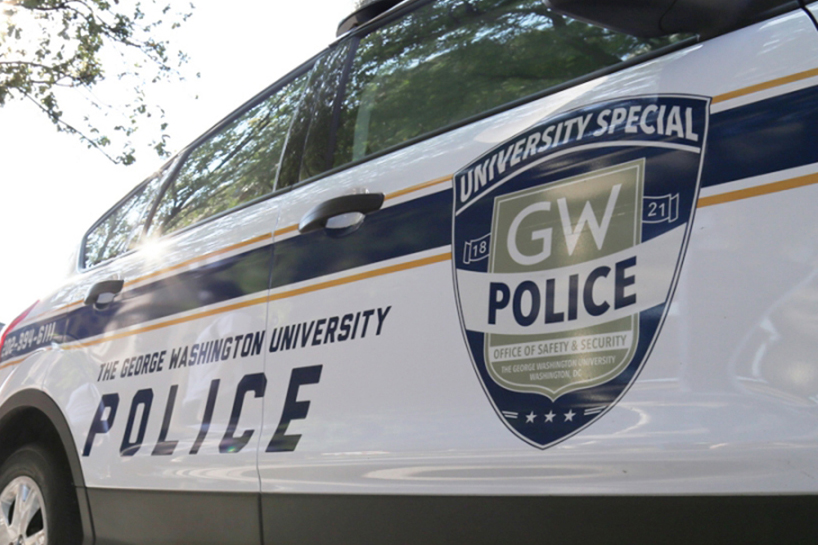By Kristen Mitchell
The number of sexual assaults and drug law violations reported at George Washington University decreased in 2015, according to the university’s annual security report released Friday.
The number of reported burglaries and robberies increased last year, although officials attributed some of the increase to a change in the way the George Washington Police Department classifies some crimes.
The report, which contains information regarding campus security and personal safety topics—including crime prevention, fire safety and disciplinary procedures—contains crime statistics for the three previous calendar years regarding crimes on campus, in certain off-campus buildings or property owned or controlled by GW, and on public property within or immediately adjacent to and accessible to campus.
There were 25 reported incidents of sexual assault in 2015 on the Foggy Bottom Campus, down from 26 in 2014, according to the report. There was an increase in the number of incidents reported to non-police – GW community members with responsibility for students Including, but not limited to, Sexual Assault Response Consultative Team members, resident assistants, residence directors, area coordinators, the Title IX office, and Office of Student Rights and Responsibilities staff – 18 in 2015 up from 17 last year.
GW Police Department Chief RaShall Brackney attributes the increase to more avenues available for reporting sexual assaults including an anonymous online option through Title IX open to those not directly involved in an incident.
“The more reports we can capture, the better we are able to educate and train to deter incidences of sexual violence and disrupt trajectories of crime on campus,” she said.
On the Mount Vernon Campus, the number of reported sexual assaults increased from one in 2014 to two in 2015. Both were reported to non-police.
Reported burglaries increased to 30 in 2015 from 11 the previous year, and the number of reported robberies increased to 10 in 2015 from three in 2014.
Ms. Brackney said when there is question whether an incident should be classified as a burglary or a theft, a less severe crime, the department often errs on the side of the more serious offense. Many of the robberies were from pickpocketing, the chief said.
Disciplinary referrals for drug law violations fell about 25 percent in 2015, according to the 44-page report, provided annually by the Office of Safety and Security and GWPD in compliance with the Jeanne Clery Disclosure of Campus Security Police and Crime Statistics Act and the Higher Education Opportunity Act.
There were 155 referrals – individual cases sent to the Office of Student Rights and Responsibilities for disciplinary action – for drug law violations on the Foggy Bottom Campus in 2015, down from 206 in 2014 and 268 in 2013.
The number of referrals for liquor law violations increased to 171 from 155 in 2014. Ms. Brackney said the change stems from an increasing awareness around the dangers of alcohol.
“We’re becoming a more responsible campus in a lot of ways, and students have an increased understanding of the impacts of alcohol, both short-term and long-term,” she said.
As part of a change in reporting requirements this year, Corcoran School of the Arts and Design Flagg Building was designated as an independent campus in the report because of its distance from the Foggy Bottom hub and proximity to non-university buildings. No crimes were reported in the building.
No new reporting categories were introduced this year. Domestic violence, dating violence and stalking were added to the report in 2013 as a result of the reauthorization of the federal Violence Against Women Act. The university reported 23 incidents of domestic violence in its third year of monitoring in Foggy Bottom, compared to 21 in 2014. Thirteen incidents of dating violence were reported, compared to zero in 2014, and four incidents of stalking were reported, compared to 10 the year before.
The university’s ability to track these crimes gives officials information on where they can push education and services, including developing personal safety plans on an individual basis, Ms. Brackney said.
GWPD recorded seven instances of disciplinary referrals for carrying or possessing weapons, an increase from zero in 2014 and 2013. The reporting definition of a weapon includes small knives and bullet casings, which Ms. Brackney said has come up when members of the GW community return to campus after target practice or shooting sports with the casings still in their possession.
“We need to continue to strive to reduce any crime, any fear, on campus,” Ms. Brackney said. “Our goal is to give students, faculty and staff the best experience here, and do anything we can do to enhance that.”
The report can be obtained from GWPD at Rome Hall. Additional information, including safety tips, crime prevention information and access to the GWPD crime log, are available online.


